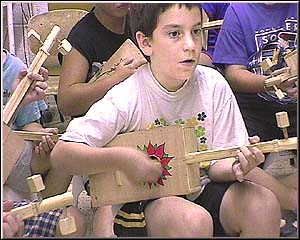MENU - INDEX - HOME
Principles
General
Teaching in a group
I. Holding Positions
1. Sitting position
2. Ancient Guitar Position
3. Left Hand
a) Placing the hand
b) Mark
and Press
4. Right Hand
5. The plectrum
II. Playing
General
1.Contents of playing
a) Open string
b) Open string
and 1
c) Open string
+ 1 + 2
2. Music Creativity
General
a) Composing
![]() b) Improvisation
b) Improvisation
c) Solo
playing
III. Music pieces
IV. Two strings
General
The pieces
Improvisation
General:
Improvisation is defined as spontaneous, unplanned playing.
However… every improvisation is based on a ground, that is an accepted foundation
(precluding the concept of independent improvisation). The importance of improvisation
lies in the fact that it gives students more freedom and choice.
Therefore, in our program improvisation is based on two factors:
![]() 1. The base line - a given line.
1. The base line - a given line.
![]() 2. The improvisation line - spontaneous
playing.
2. The improvisation line - spontaneous
playing.


